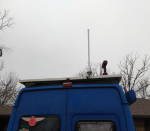How about those cascading projects? :********: I wanted to add a tank level sensor to my Color Control, the little icon says "no tanks" had stared at me long enough. I have a SeeLevel gauge on it, JUNK. Stick on sensor that doesn't stick on, is inaccessible etc. It sucks.
So Victron makes a resistive sensor adaptor for the color control. Easy, it uses the can bus connection and I have a free slot there. Order the stupidly over priced adapter. Add tank sensor (KUS REALLY nice piece for the price). Run the wires, which is a major **********, they are at the back of a 48" deep, 9" wide drawer. I cant reach it, and I don't fit in that hole. But the wires are run, ends terminated, hook it up and nothing. After some googling, Well it turns out the color control does not power the can bus network. you need another over priced widget to power it. ******** this ********. For a few bucks more I can get the Cerbo, and the touchscreen. It has way more capability than the color control, including built in tank monitoring for like 6 tanks?
Returned the over priced adapter, ordered a cerbo. Oh but wait, the touch screen is a different size than the color control, of course it is.... And I have a cutout sized for the color control. Some more googling says they make an adapter. OK fine. Order that too.
So all the connections are at the back of the color control. The cerbo is a bigger box.... So I will need to re route all this ********.
Sender in the tank, set in 3m 4000. Its all stainless, fuel and water rated. And the stupid adapter thing I immediately ripped back out.
Big ass hole.
And the adapter, the bezel is so ************** huge. Well that wont work either. (and I didn't set up an acct when I ordered it so I cant return it now....)
Fawk it. Sheet of abs, make my own damn adapter.
Mounted the cerbo on the other wall, re routed all the cables. Meh. Its a little messy. Oh and why do they put ************** blinking LED's on everything?? Electrical tape to the rescue.
Well it works and I can see my water level. Now to run a wire to the propane tank :********:



